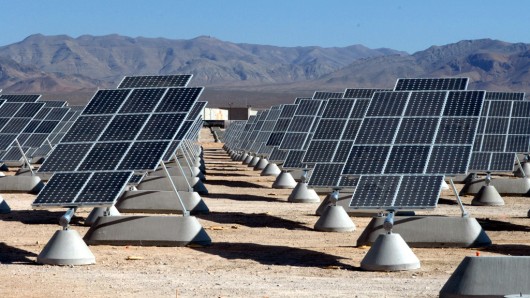
Deserts are the obvious locations for solar power plants. The land is cheap and the sunshine is plentiful. Unfortunately so too is the dust, dirt and wind that leads to dirty solar panels that can take a big hit in efficiency. Sending a guy around with a squeegee in the sweltering heat doesn’t sound like the best job in the world and self-cleaning systems that rely on water aren’t always an option in areas where clean water is hard to come by. Another solution is self-dusting solar panels that are cleaned by an electric charge provided by the solar panels themselves. The self-dusting solar panels are based on technology developed for another dry and dusty environment – Mars.
The technology involves placing a transparent, electrically sensitive material deposited on glass or a transparent plastic sheet covering the panels. Sensors monitor dust levels on the surface of the panel and energize the material when dust concentration reaches a critical level. The electric charge sends a dust-repelling wave cascading over the surface of the material, lifting away the dust and transporting it off of the screen's edges.
Within two minutes, the process removes about 90 percent of the dust deposited on the panels and requires only a small amount of electricity generated by the panel for cleaning purposes.
"We think our self-cleaning panels used in areas of high dust and particulate pollutant concentrations will highly benefit the systems' solar energy output," study leader Malay K. Mazumder, Ph.D. said. "A dust layer of one-seventh of an ounce per square yard decreases solar power conversion by 40 percent," Mazumder explains. "In Arizona, dust is deposited each month at about 4 times that amount. Deposition rates are even higher in the Middle East, Australia, and India."
Mazumder, who is with Boston University, said the need for that technology is growing with the popularity of solar energy. Use of solar, or photovoltaic, panels increased by 50 percent from 2003 to 2008, and forecasts suggest a growth rate of at least 25 percent annually into the future.
"Our technology can be used in both small- and large-scale photovoltaic systems. To our knowledge, this is the only technology for automatic dust cleaning that doesn't require water or mechanical movement."
Working with NASA, Mazumder and colleagues initially developed the self-cleaning solar panel technology for use in lunar and Mars missions. "Mars of course is a dusty and dry environment," Mazumder said, "and solar panels powering rovers and future manned and robotic missions must not succumb to dust deposition. But neither should the solar panels here on Earth."
The current market size for solar panels is about $24 billion, Mazumder said. "Less than 0.04 percent of global energy production is derived from solar panels, but if only four percent of the world's deserts were dedicated to solar power harvesting, our energy needs could be completely met worldwide. This self-cleaning technology can play an important role."
The team described the benefits of the self-cleaning coating in a report at the 240th National Meeting of the American Chemical Society (ACS).
Copyright © gizmag 2003 - 2010 To subscribe or visit go to: http://www.gizmag.com